The Lockdown Projects - Page 3
On this page there will be displays of work created by Members whilst on lockdown. These are the 'Lockdown Projects'. This is the equivalent of the 'display table' from Club nights. This is Page 3 of the projects - click HERE to display Page 1 or HERE to display Page 2 and HERE to display Page 4 or HERE to display Page 5
or HERE to display Page 6
Here is some of the Members' work created in lockdown…
| Richard Balmforth has been busy in his workshop and says: He has turned a few things over lockdown, some of which worked out and some didn't - so, back to the drawing board. Well, here's one that is one of the better ones. This is a laminated plywood bowl 13" diameter - built up in three layers of 1" thick birch plywood. The total weight is around 4kg, definitely hard hat stuff! The bowl was turned and hollowed - then stained with multi-coloured Hampshire Sheen stains. Next - pebbles and shells were positioned and super glued to the bowl interior - then filled with blue tinted epoxy resin. Finally, sanded and polished. I think there are some deep sea divers hiding in there, as in the morning, I found a number of air bubbles on the way up - which is annoying, but probably unavoidable. We can't get to the seaside at the moment - so thought this would be a little reminder of our seaside dreams - walking along the beach and gazing into rock pools... |
|
 |
 |
| Robert Duffy has been working with texture and colour on these large platters. The green texture platter is sycamore using Chestnut spirit stains, sanding sealer and wax products, the size is approx. 14" diameter by 3" deep. The Robert Sorby small texturing tool was used in the centre and around the inner edge. This ash platter is approx. 10" diameter by 4" deep - using Chestnut sanding sealer, and Hampshire Sheen black embellishing paste wax to highlight the grain and then buffed using the Chestnut Buffing Wheel Kit. |
|
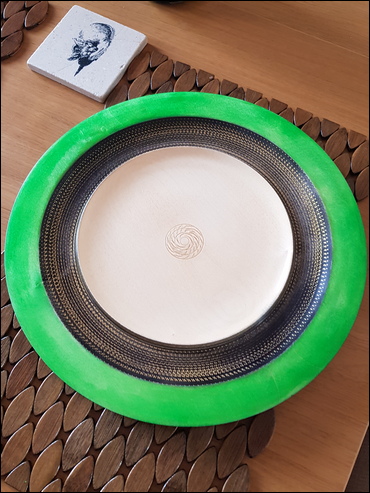 |
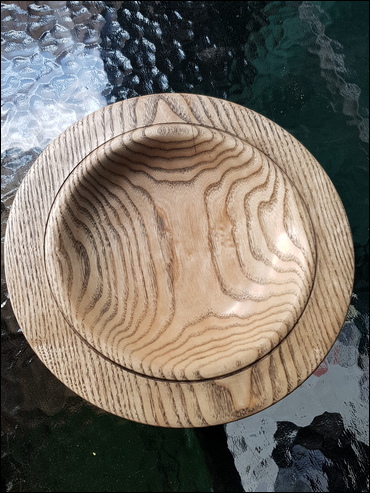 |
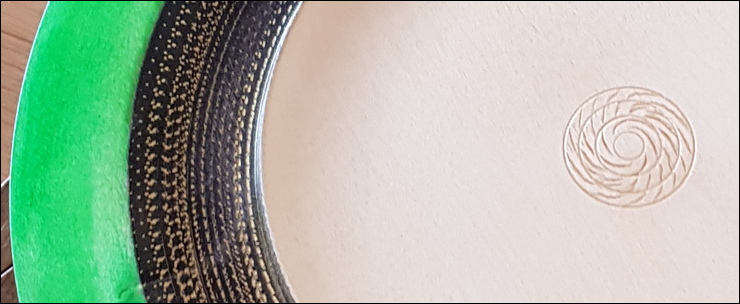 |
|
| John Sawyer has sent a couple of projects he has been working on. |
|
| The salt/ spice pot in beech is approx. 2" diameter with a friction fit lid. The potato masher in spalted beech is exactly 63 mm diameter - as per the customer specification (reason undisclosed)... There was a small void on the end that was filled with woodglue and sawdust. Both items are finished with flax oil. |
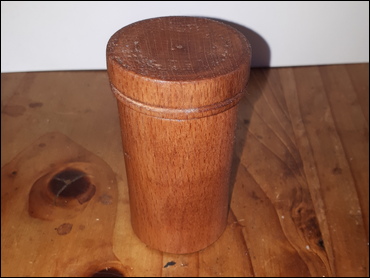 |
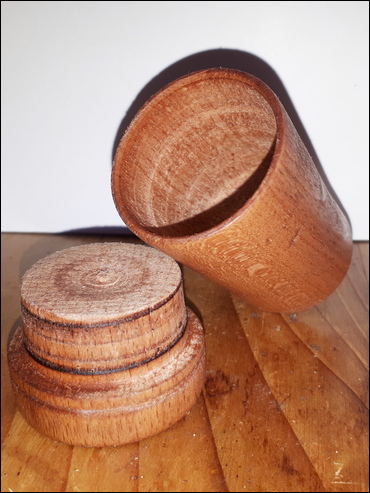 |
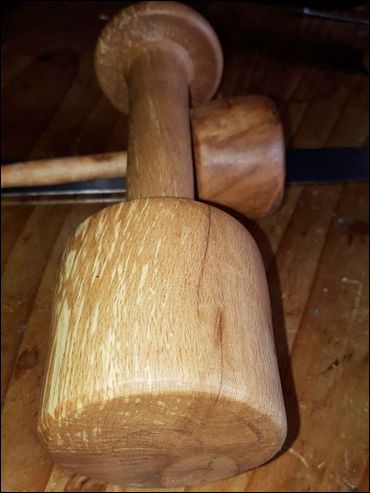 |
| Dave Newman says - I decided to make a garden ornament for my wife. I had a huge oblong lump of weathered oak that one of my fellow Canal and River Trust volunteers had given me, "because you turn wood," it was rather nice, but I didn't know what to do with it! Initially I stood it on end in the gravel at the bottom of my garden .... and looked at it for several weeks. Eventually I thought, that it would look good with some gnarly split toadstools growing out of the top. I had some split logs of Yew and Lilac, also a nice offcut of oak. So I made three toadstools of varying size and shape between 4" and 10" tall. I made copper staples to bridge the splits and hammered a copper rivet into the mark at the top of the toadstool left by the live centre, in good Steam Punk style. Plus it saved me having to sand out the live centre indentation. I turned the end of the stalks to a diameter that suited a Forstner bit, then drilled the end grain of the oak lump so I could set two of the toadstools at different pleasing angles. For the smallest dumpy Lilac toadstool, I drilled the base and secured it with two brass screws. |
|
 |
 |
| My neighbour liked my oak block plus toadstools so much that he asked me to make one for him. I no longer had any Oak large enough, so I sent him out to hunt for some wood of his choice in Hodson Wood - and he came back with a nice slice of Elm, covered in moss from a felled tree. It was made pretty much in the style of my first garden ornament - with the toadstools in Yew and Lilac. Both pieces were finished with Linseed Oil, hoping it will give them some protection from the weather. |
 |
| Harry has sent a couple of projects he has been working on. |
|
| Inspiration for these pieces was a photo seen on the internet. Basically, it's 4 end grain sections of a branch glued together. The visual effect of the end grain is really nice - something we do not see too often. The first piece in yew is 2.75" diameter by 8.5" tall with a 1.75" diameter hole to within 1" of the base. The process is very wasteful of timber and a lot ends up as shavings. The 4-sections were glued together 'face to face'. Structurally, this is quite fragile - the glued surface area is quite small and would not respond well to sideways pressure… The second column in very cracked laburnum is 3" diameter by 10.25" tall with a 2.125" diameter hole to within 1" of the base. To improve the structural strength each section has a box lid type fitted tenon to join them together. This greatly increased the glued surface area - and helped with the alignment on assembly. The cracks/ holes were filled with aluminium powder and superglue. Both 'columns'/ weed pots were sanded to 400 grit, cellulose sanding sealer applied, buffed and given a coat of microcrystalline wax. |
 |

|
 |
| An apple and a pear made in laminated birch plywood. Three pieces of 1" thick ply glued together. Not particularly nice to turn - it's all splinters! - although, the result shows an interesting 'grain' pattern. The apple is approx. 2.625" diameter by 3.25" tall to include the African blackwood stalk. The pear is 2.5" diameter by 4.5" tall including the stalk. Both pieces were sanded to 320 grit, cellulose sanding sealer applied, buffed and given a coat of microcrystalline wax. |
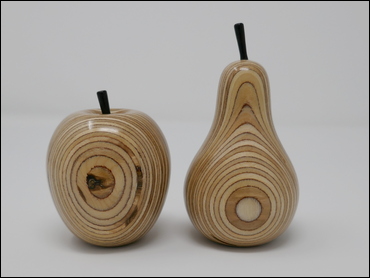 |
| Graham Furze was pleased to declare that his lathe was now back in action, after not being used for many years. Graham bought it in 1980 after doing a series of evening classes at the Swindon College in Regent Circus (now a Morrisons store!). He says, I used it a lot in the early days, but for various reasons have not been able to use it again until now. It's great to be back using it again, but I need a lot more practice in both turning and finishing! Handle for Gouge: Before: I bought the gouge from Les Thorne when he visited the Club a few years ago. I have recycled an 'ancient' rolling pin (probably) made of beech - the ferrule was made from section of brass tubing. After: Custom handle completed - the gouge is secured in place with epoxy resin. |
|
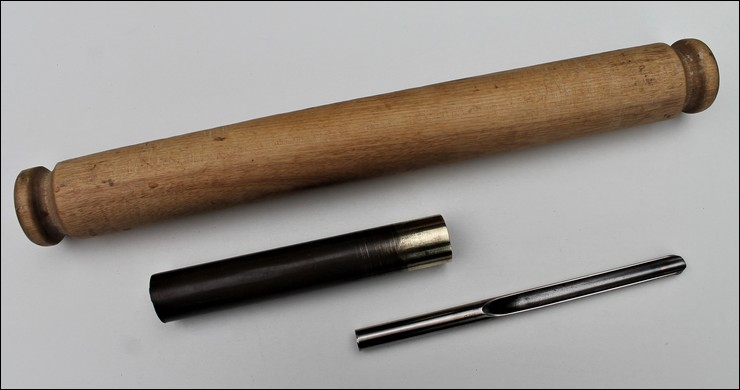 |
|
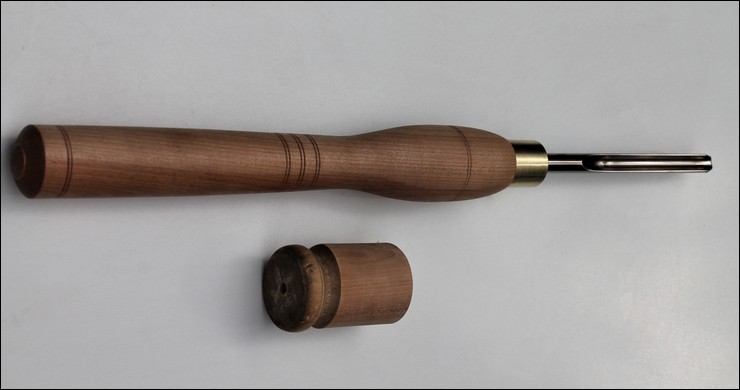 |
|
| The vase on the left is made from beech(?), approx. 160 mm (6.5") tall. Finished with sanding sealer and carnauba wax. The vase on the right is in beech, approx 100 mm (4") tall. |
|
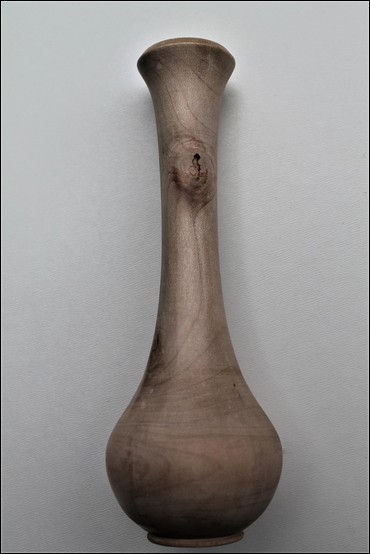 |
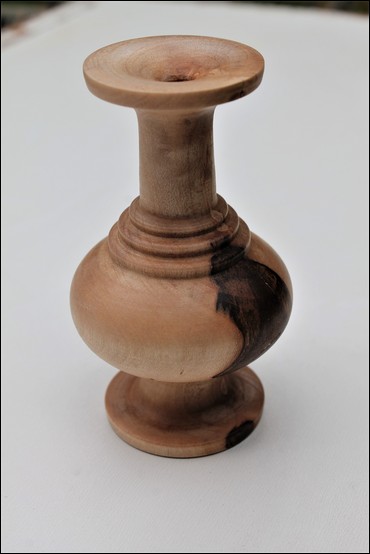 |
| Bob Sawyer - This is Mark ll of a prototype/ experiment Bob first showed on Page 2 of the Lockdown Projects. Progressing from lessons learnt previously, this completed item is in English brown oak, with a willow basket weave section and is approx. 6.5" (165 mm) diameter by 8.6" (220 mm) tall. Bob says that: "If and when I do a Mark lll, I will drill the holes for the metal rods with the pillar drill not freehand..." |
|
| I asked Bob what the item was called - i.e. how to describe it? He responded with a Subject line on the email of "Basket Case" and "I think giving it a name is a bit too arty fatty (sic)" Exercising my 'blue editorial pencil' - I think this description might be suitable: "This is a unique, one-off, highly desirable artwork created by a long-established Wiltshire based professional craftsman. Meticulously hand-turned in figured English brown oak, intended to be table or shelf mounted, this designer lantern with an artisan feature of a willow basket weave centre section on a stainless steel support system; would be a prestigious addition to any commercial or domestic environment. Supplied with a battery operated, optional/ removable internal lighting fixture that ehances the versatility of the piece. This much sought-after and rare masterpiece could alternatively be utilised as an under-desk repository for superfluous paper items" 😊😊😊 (Harry) |
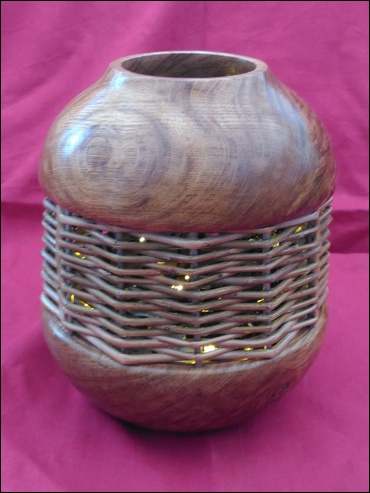 |
| Arthur Kingdon continues to be busy in his workshop. |
|
| Needing a replacement for a mantle clock that had expired - Arthur 're-discovered' a number of clock inserts. In a break from his usual ornamental turning he used his conventional Nova DVR lathe to create a clock mounting. An early 'test' proved that a skeleton clock insert was unreadable from a distance... The final result was a 4" diameter movement mounted in a burr oak collar on a burr oak stand with African blackwood support and decoration. |
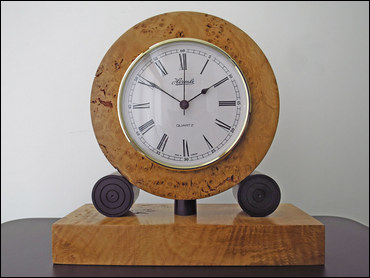 |
| Here is a lidded box in African blackwood, with betel nut finial. Spiral fluting on the box body and an eccentric pattern on the lid done on an Evans ornamental turning lathe c1880. Decorated inside and on the base using a rose engine (a modern conversion using a Holtzapffel headstock and bed). The outside diameter is approx. 68 mm. |
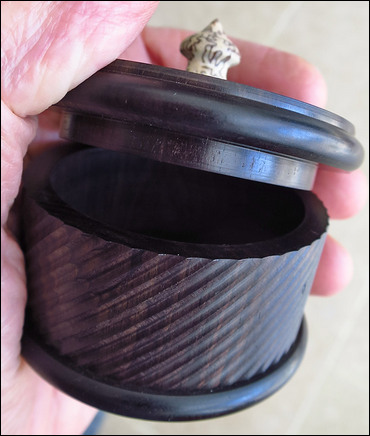 |
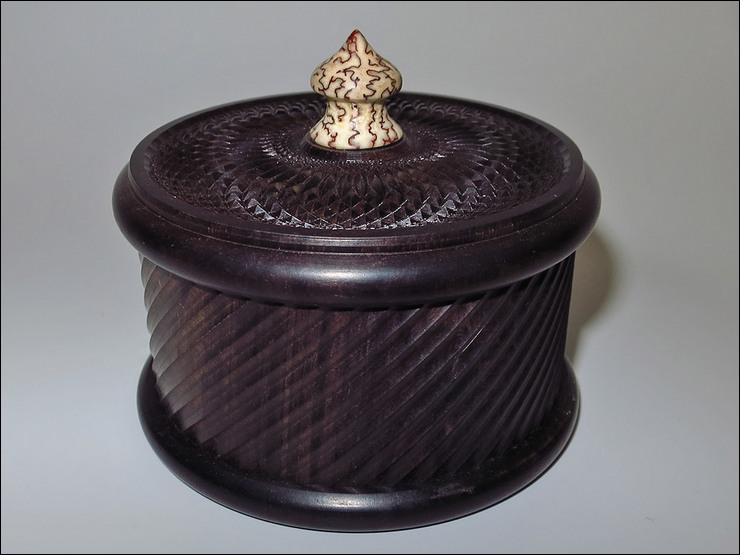 |
|
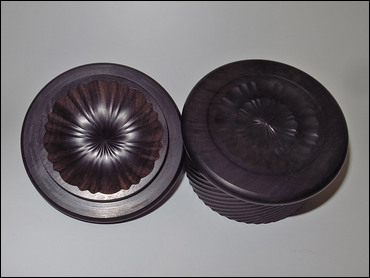 |
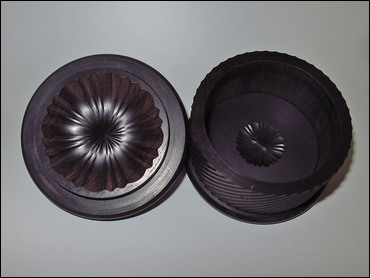 |
Arthur's major passion in woodturning is the making of complex ornamental boxes. He has several ornamental turning lathes and for a while had an "MDF Rose Engine" on loan from a friend. He has now made his own version of this machine. The rose engine has been made pretty much in accordance with the design available on the Internet at MDF Rose Engine. For anyone interested in ornamental turning or rose engines - how they work and what sort of pieces can be generated etc.- a few hours spent on this website will provide a fascinating insight.
The rose engine is made from half a sheet of MDF, biscuit joined and glued together making for a pretty strong construction.
Arthur has used a spindle from a Myford ML7 metalworking lathe, which was purchased via eBay from a chap in Penhill - for the grand sum of £10. It has a number 2 Morse taper which it is hoped will be useful when transferring work between the different machines.
The pictures (below) show various stages of construction and then the first trial with a piece of boxwood. Note: the sliderest, which is also a Myford item, was held in position with G-clamps pending a better arrangement. The rose engine has since had a sheet of 3mm steel fixed to the top and the sliderest is now secured using magnetic switches (£140 for four). There are several low cost ways of securing the sliderest, but this is a very convenient arrangement.
MDF base construction - strong box sections - biscuit joined plus glue, and lots of clamps. A photo showing the main pulley/ rosette holder being very accurately machined on a Holtzapffel ornamental lathe. Made of MDF but drilled and tapped to hold rosettes. |
|
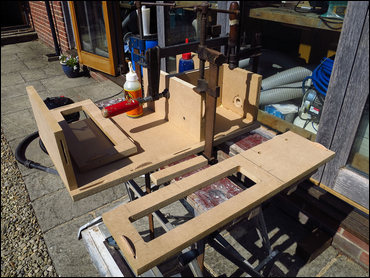 |
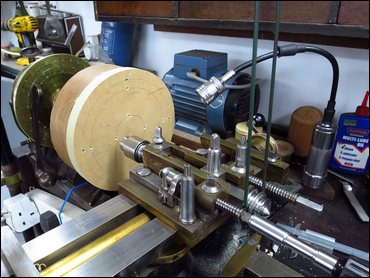 |
The tapped holes were strengthened with CA glue and seem more than strong enough. Initial trials/ testing on a boxwood workpiece using G-clamps to hold the sliderest - this provides precise 'X' and 'Y' axis motion. |
|
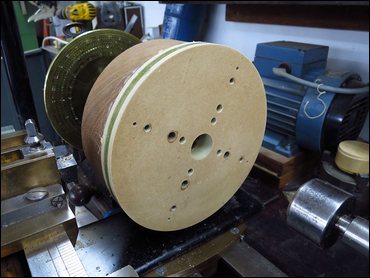 |
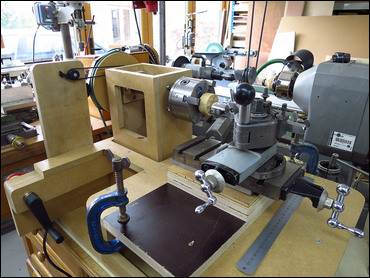 |
First attempt at a 'proper' project - with an African blackwood blank - eccentric patterns (on the box lid) were achieved using an eccentric chuck from Arthur's Holtzapffel lathe (serial no. 752) dating from 1811. A view of the perspex rosette - which produces the 'rocking' motion on the headstock - and the 'rubber' assembly mounted on 'T' track. |
|
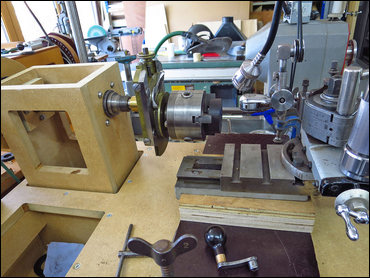 |
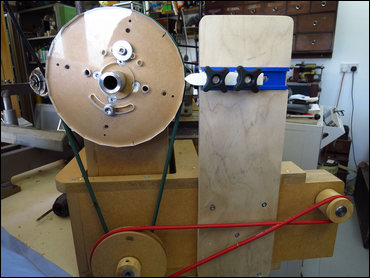 |
Close up view of the chuck and cutter assembly/ frame - with the sliderest now held with magnetic clamps. The single-point cutter (similar to a fly-cutter) spins at around 5,000 rpm. The cutting frame is of modern manufacture and retails for about £250, but it is possible to use a router or a Dremel as a viable alternative. Overall view of the machine showing the drive unit (a small modified bench grinder) and overhead pulleys to drive the cutter. The rods and pulleys are from an old metalworking lathe |
|
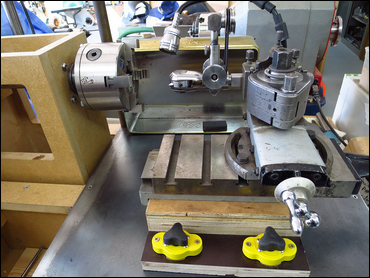 |
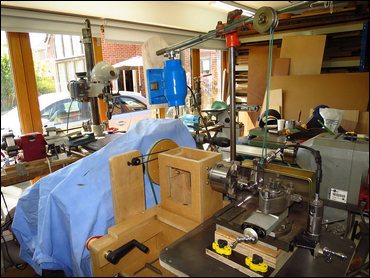 |
A completed ornamental box in African blackwood - created on the MDF Rose Engine. |
|
| The box measures approx. 55mm diameter by 32mm tall. The box lid was the first project on the new lathe and this was decorated all over including eccentric patterns. The box was decorated on the base and inside the lid. A piece of pewter sheet was inserted between the base and lid. |
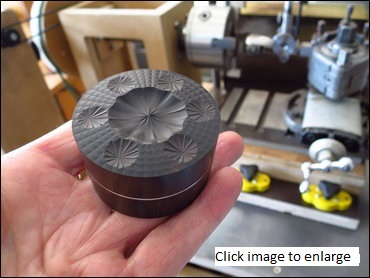 |
| <Top of Page> |
|
